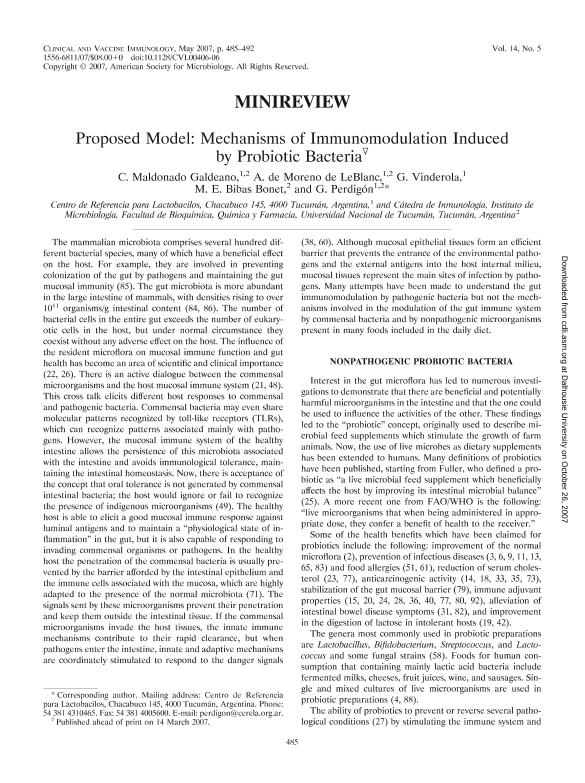Artículo
Proposed model: Mechanisms of immunomodulation induced by probiotic bacteria
Maldonado Galdeano, María Carolina ; de Moreno, Maria Alejandra
; de Moreno, Maria Alejandra ; Vinderola, Celso Gabriel
; Vinderola, Celso Gabriel ; Bibas Bonet, María Eugenia; Perdigon, Gabriela del Valle
; Bibas Bonet, María Eugenia; Perdigon, Gabriela del Valle
 ; de Moreno, Maria Alejandra
; de Moreno, Maria Alejandra ; Vinderola, Celso Gabriel
; Vinderola, Celso Gabriel ; Bibas Bonet, María Eugenia; Perdigon, Gabriela del Valle
; Bibas Bonet, María Eugenia; Perdigon, Gabriela del Valle
Fecha de publicación:
12/05/2007
Editorial:
American Society for Microbiology
Revista:
Clinical and Vaccine Immunology
ISSN:
1556-6811
e-ISSN:
1556-679X
Idioma:
Inglés
Tipo de recurso:
Artículo publicado
Clasificación temática:
Resumen
The mammalian microbiota comprises several hundred different bacterial species, many of which have a beneficial effect on the host. For example, they are involved in preventing colonization of the gut by pathogens and maintaining the gut mucosal immunity (85). The gut microbiota is more abundant in the large intestine of mammals, with densities rising to over 1011 organisms/g intestinal content (84, 86). The number of bacterial cells in the entire gut exceeds the number of eukaryotic
cells in the host, but under normal circumstance they coexist without any adverse effect on the host. The influence of the resident microflora on mucosal immune function and gut health has become an area of scientific and clinical importance
(22, 26). There is an active dialogue between the commensal microorganisms and the host mucosal immune system (21, 48). This cross talk elicits different host responses to commensal and pathogenic bacteria. Commensal bacteria may even share molecular patterns recognized by toll-like receptors (TLRs), which can recognize patterns associated mainly with pathogens. However, the mucosal immune system of the healthy intestine allows the persistence of this microbiota associated with the intestine and avoids immunological tolerance, maintaining
the intestinal homeostasis. Now, there is acceptance of the concept that oral tolerance is not generated by commensal intestinal bacteria; the host would ignore or fail to recognize the presence of indigenous microorganisms (49). The healthy
host is able to elicit a good mucosal immune response against luminal antigens and to maintain a “physiological state of inflammation” in the gut, but it is also capable of responding to invading commensal organisms or pathogens. In the healthy
host the penetration of the commensal bacteria is usually prevented by the barrier afforded by the intestinal epithelium and the immune cells associated with the mucosa, which are highly adapted to the presence of the normal microbiota (71). The
signals sent by these microorganisms prevent their penetration and keep them outside the intestinal tissue. If the commensal microorganisms invade the host tissues, the innate immune mechanisms contribute to their rapid clearance, but when
pathogens enter the intestine, innate and adaptive mechanisms are coordinately stimulated to respond to the danger signals (38, 60). Although mucosal epithelial tissues form an efficient barrier that prevents the entrance of the environmental pathogens and the external antigens into the host internal milieu, mucosal tissues represent the main sites of infection by pathogens. Many attempts have been made to understand the gut immunomodulation by pathogenic bacteria but not the mechanisms involved in the modulation of the gut immune system by commensal bacteria and by nonpathogenic microorganisms present in many foods included in the daily diet.
Palabras clave:
Immunomodulation
,
Probiotic
,
Immune Mechanisms
Archivos asociados
Licencia
Identificadores
Colecciones
Articulos(CERELA)
Articulos de CENTRO DE REFERENCIA PARA LACTOBACILOS (I)
Articulos de CENTRO DE REFERENCIA PARA LACTOBACILOS (I)
Articulos(INLAIN)
Articulos de INST.DE LACTOLOGIA INDUSTRIAL
Articulos de INST.DE LACTOLOGIA INDUSTRIAL
Citación
Maldonado Galdeano, María Carolina; de Moreno, Maria Alejandra; Vinderola, Celso Gabriel; Bibas Bonet, María Eugenia; Perdigon, Gabriela del Valle; Proposed model: Mechanisms of immunomodulation induced by probiotic bacteria; American Society for Microbiology; Clinical and Vaccine Immunology; 14; 5; 12-5-2007; 485-492
Compartir
Altmétricas



